
Sunny microclimates
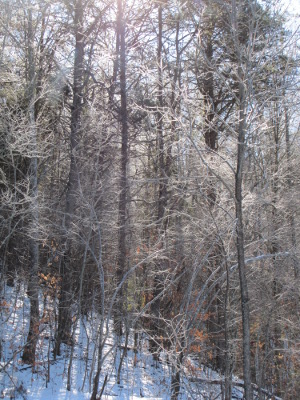 After
over four years gardening on the same two acres of vegetables, orchard,
and chicken pasture, I'm constantly surprised at how little I know
about the yard's microclimates. As Eliza pointed out on her blog,
snow-melt
is a perfect time to get those microclimates pertaining to sun figured
out --- sunny spots
will be the first to melt while shady spots will keep their snow for
hours or days longer. Our accumulated December snow took days to
melt (tiny bits of it are still out there), so I had a perfect
opportunity to scope out sunny spots day by day.
After
over four years gardening on the same two acres of vegetables, orchard,
and chicken pasture, I'm constantly surprised at how little I know
about the yard's microclimates. As Eliza pointed out on her blog,
snow-melt
is a perfect time to get those microclimates pertaining to sun figured
out --- sunny spots
will be the first to melt while shady spots will keep their snow for
hours or days longer. Our accumulated December snow took days to
melt (tiny bits of it are still out there), so I had a perfect
opportunity to scope out sunny spots day by day.
We live in pretty much
the worst place for gardening in the winter --- on a north-facing slope
on the north side of a hill. As the sun sinks lower into the sky
during the colder months, more and more of the area up against the hill
remains in shadow, and I look with longing at our neighbor's hay field,
across the creek and far enough from the hill that frost on the field 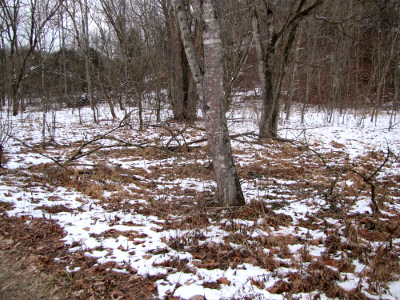 melts
hours before it does in our garden. So I was a bit surprised to
realize that a gap in the hills made an area just beyond the mule
garden melt off even before my neighbor's field did. Doesn't this
look like the absolutely perfect spot for a winter forest pasture? Can't you just
imagine how happy our flock would be, scratching through these leaves,
when their current pasture is still socked in under three inches of
snow and ice?
melts
hours before it does in our garden. So I was a bit surprised to
realize that a gap in the hills made an area just beyond the mule
garden melt off even before my neighbor's field did. Doesn't this
look like the absolutely perfect spot for a winter forest pasture? Can't you just
imagine how happy our flock would be, scratching through these leaves,
when their current pasture is still socked in under three inches of
snow and ice?
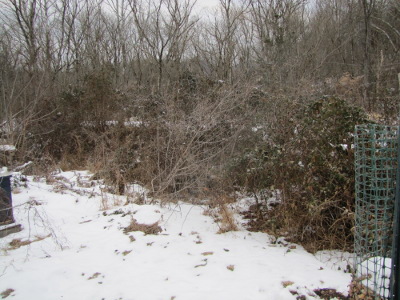 Moving
back toward our main yard, I realized that we had another abnormally
sunny spot --- the south-facing side of the gully that divides our mule
garden from our back garden. Seeing the bare soil on this sheer
south face while everything around it was covered with snow made me
realize that I'm leaving a lot of sun on the table by letting this spot
grow up in weeds. Maybe we should put Mark's hobbit cave here
(assuming we could deal with drainage since the bottom of the gully
stays good and damp.) Or perhaps this would be a good spot to
terrace and plant sun-loving something-or-other halfway up the south
face? If we went to all of the work of building a stone wall
behind the terrace, I'll bet we could gain as much as two climate zones
and plant just about anything we want there.
Moving
back toward our main yard, I realized that we had another abnormally
sunny spot --- the south-facing side of the gully that divides our mule
garden from our back garden. Seeing the bare soil on this sheer
south face while everything around it was covered with snow made me
realize that I'm leaving a lot of sun on the table by letting this spot
grow up in weeds. Maybe we should put Mark's hobbit cave here
(assuming we could deal with drainage since the bottom of the gully
stays good and damp.) Or perhaps this would be a good spot to
terrace and plant sun-loving something-or-other halfway up the south
face? If we went to all of the work of building a stone wall
behind the terrace, I'll bet we could gain as much as two climate zones
and plant just about anything we want there.
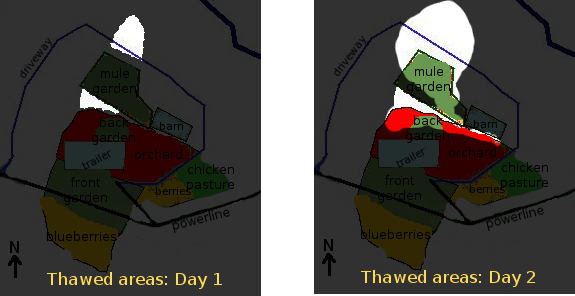
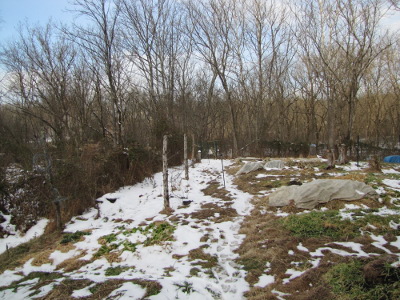 And
now for the bad news. Since the gully has never been reclaimed
(aka mowed), young trees, briars, and Japanese honeysuckle create a
wall along the south side of the mule garden. Here, in our
sunniest piece of flat ground, I'm wasting an eight foot strip of
growing area along the southern edge due to deep shade from my briar
bushes. We clearly need to find a way to get that gully under
control so that the mule garden will work even better as our sunny
winter garden spot.
And
now for the bad news. Since the gully has never been reclaimed
(aka mowed), young trees, briars, and Japanese honeysuckle create a
wall along the south side of the mule garden. Here, in our
sunniest piece of flat ground, I'm wasting an eight foot strip of
growing area along the southern edge due to deep shade from my briar
bushes. We clearly need to find a way to get that gully under
control so that the mule garden will work even better as our sunny
winter garden spot.
Want more in-depth information? Browse through our books.
Or explore more posts by date or by subject.
About us: Anna Hess and Mark Hamilton spent over a decade living self-sufficiently in the mountains of Virginia before moving north to start over from scratch in the foothills of Ohio. They've experimented with permaculture, no-till gardening, trailersteading, home-based microbusinesses and much more, writing about their adventures in both blogs and books.
Want to be notified when new comments are posted on this page? Click on the RSS button after you add a comment to subscribe to the comment feed, or simply check the box beside "email replies to me" while writing your comment.
- Remove comment

- Remove comment
